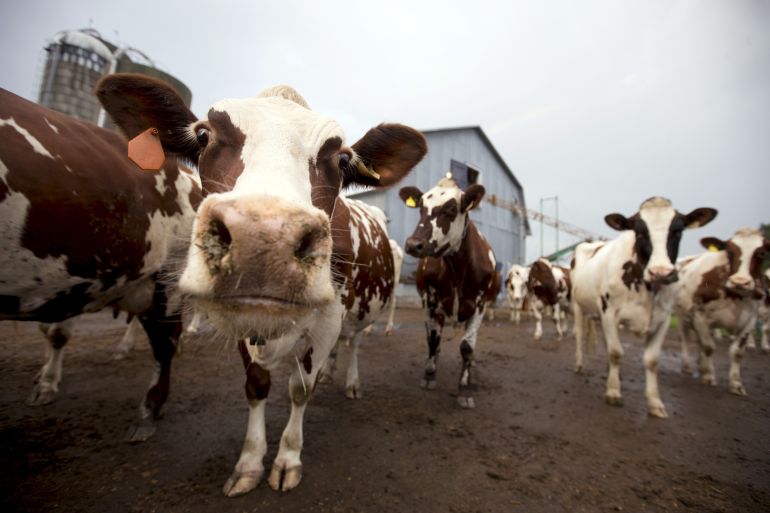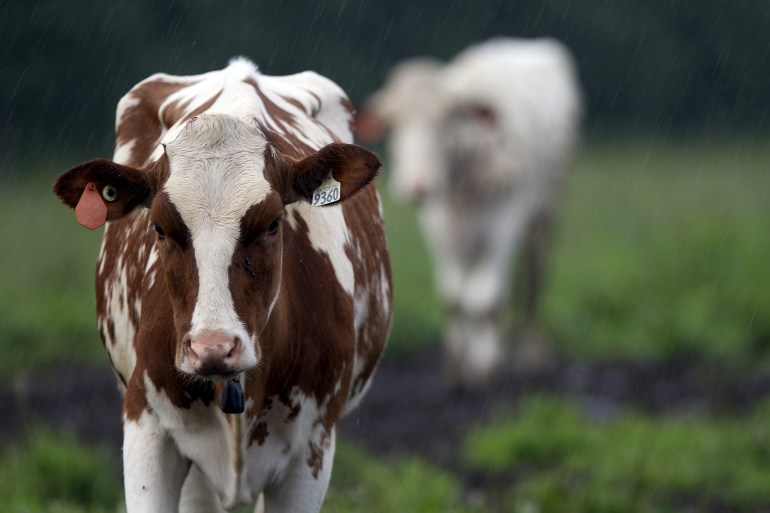Herd of fugitive cows frustrates tiny village in Canada
A tale of hard-to-catch young dairy cows is capturing attention – and imaginations – in the province of Quebec.

Montreal, Canada – Marie-Andree Cadorette was getting desperate.
After being punted between government, police and animal welfare agencies, each saying they couldn’t do anything to help, the general manager of the tiny Canadian village of Saint-Severe, Quebec – population 320 – needed reinforcements.
Keep reading
list of 3 itemsNew Zealand farmers protest world’s first livestock ‘burp tax’
Livestock is a form of climate justice in the Global South
Eight cowboys on horseback answered her call, equipped with a drone and fencing. Their target? A group of young runaway cows that has been on the lam since the summer, wreaking havoc and causing tens of thousands of dollars in damages in the largely rural area.
“They succeeded in encircling them,” Cadorette said in an interview with Radio-Canada’s widely watched Sunday evening programme, Tout le monde en parle. “But unfortunately, the heifers passed by a field of corn that hadn’t been harvested yet, and they fled into the cornfield.
“And then there was nothing left to do.”
The tale of the approximately two dozen missing farm animals has captured media and public attention across the French-speaking province of Quebec, with the agricultural ministry calling the situation “complex and unprecedented”.
It even reached Canada’s Senate last week, as Senator Julie Miville-Dechene expressed her “amused admiration” for the young bovines, which she said had “recovered their freedom”.
Hommage à des vaches inspirantes et à Marie-Andrée Cadorette, directrice générale de Saint-Sévère, une femme qui n'a pas froid aux yeux. #polqc #vaches #liberté pic.twitter.com/FDxdPARwK0
— Julie Miville-Dechêne (@mivillej) November 23, 2022
Translation: A tribute to inspiring cows and to Marie-Andree Cadorette, general manager of Saint-Severe, a fearless woman. #polqc #cows #freedom
Fear of road accidents
For the tiny village of Saint-Severe, the saga of the young dairy cows has been a frustrating headache. Since going to the media, Cadorette said she has received more than 200 emails from members of the public, each proposing solutions to bring an end to the drama.
The most common piece of advice? Try to lure them by playing the recorder, she told Radio-Canada, laughing. But that, too, failed. (Yes, she tried it – though mainly to bring levity to the situation, she said.)
The group of mostly heifers – young cows that have not yet bred calves – has been on the loose since July, local media reported. They are believed to have jumped a fence on a dairy farm in the municipality of Saint-Barnabe, about 5km (3 miles) from Saint-Severe, after being scared during a thunderstorm, according to Saint-Severe’s Mayor Jean-Yves St-Arnaud.
“When it became concerning for us was as soon as they got out of the woods and came towards private homes. They were also going near young people, children, crossing the street … it became dangerous,” St-Arnaud said on Tout le monde en parle on Sunday.
He said the young cows have not had much human contact and are scared, which makes catching them more difficult. “We’re not talking about a cow that is wild; we’re talking more about a cow that’s agitated, that’s anxious, that doesn’t know much about human beings,” St-Arnaud said.
The cows’ owner, Pierre Lapointe, told local news outlet Le Nouvelliste last week that he wanted a month to try to get them back. He said the cows had been with the herd of 200 for less than a month before they bolted due to the storm.
“This has never happened in 40 years,” Lapointe said.
‘All-you-can-eat buffet’
The cows have been able to survive since their escape by eating unharvested corn and other crops and drinking from streams in the area, about 130km (81 miles) east of Montreal, Quebec’s largest city.
But with local harvesting completed and temperatures dropping, Cadorette said the situation has become more serious. “They had an all-you-can-eat buffet all summer,” she said during the Radio-Canada interview. “But now as we speak, the harvests are done. There isn’t much left to eat … it’s really an emergency to recover them.”
Elsa Vasseur, associate professor at McGill University and research chair in the sustainable life of dairy cattle, said the young age of the escapees – heifers do not yet need to be milked – means that their main concern is finding food.
And as readily available food supplies dwindle in the winter, efforts to catch the herd should be more successful. “As soon as the food runs out, they will try to find the most strategic way to get food,” she told Al Jazeera.
Cows, she said, are generally very curious creatures, and they also live in groups, which makes the communal escape unsurprising. “As soon as one runs away, generally it won’t be alone,” she said.
The danger of the ongoing evasion, Vasseur added, is having cows in places drivers don’t expect them to be. “If you think about Iceland, for example, or Ireland or Corsica, animals wander, cows wander, so people are aware of that,” she said, whereas in Quebec, people travelling on a country road “don’t expect to come face-to-face with a cow, or a pig, or a horse”.

The plan
On Saturday, Quebec’s ministry of agriculture, fisheries and food said it had deployed a team of experts to plan out next steps in coordination with other partners.
“Facing a complex and unprecedented situation, the ministry firstly is accompanying the owner who has said he wants to recover his herd,” the ministry said in a statement, adding that it needed to take into account the wellbeing of the cows and the safety of residents, among other factors.
The local branch of the Union of Agricultural Producers (UPA, according to its French-language acronym) said on Monday that the “game plan” is to use strategically positioned feeders to provide the cows with food, and then capture them “when the time comes”.
“We primarily have two concerns in this situation: making sure the animals are in good health (and remain so during the course of the operation) and that the animals don’t end up on public roads,” the union said. “Until then, the order of the day is: patience. It will take time, but we will keep you informed when the operation is completed successfully.”
The mayor of Saint-Severe also recently urged residents to not get in the way of these efforts.
So while the story has captured imaginations, for the people of Saint-Severe, it can’t end soon enough. “It would be wonderful,” Cadorette said at the end of her Radio-Canada interview, “if it was taking place somewhere else.”